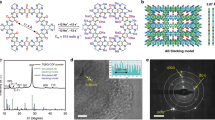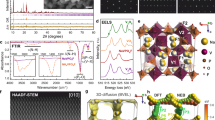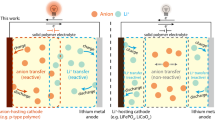Abstract
A novel vinyl polymer bearing an extended conjugated disodium dicarboxylate structure, specifically, the terphenyl side chain structure, which has a favorable electrochemical performance, has been synthesized and evaluated as an anode for sodium-ion batteries. The electrochemical performance was significantly improved over that of the vinyl polymer with disodium terephthalate. In particular, the discharge potential shifted by ~0.1 V to a lower potential at 0.28 V (vs. Na/Na+). Additionally, a specific capacity of 121 mAh g–1 at 10 mA g–1, which corresponds to an 88% theoretical capacity, was observed. Moreover, better rate performance was also achieved through the extended π-conjugated system.
This is a preview of subscription content, access via your institution
Access options
Subscribe to this journal
Receive 12 print issues and online access
$259.00 per year
only $21.58 per issue
Buy this article
- Purchase on Springer Link
- Instant access to full article PDF
Prices may be subject to local taxes which are calculated during checkout









Similar content being viewed by others
References
Amin K, Mao L, Wei Z. Recent progress in polymeric carbonyl-based electrode materials for lithium and sodium ion batteries. Macromol Rapid Commumn. 2019;40:1800565.
Rajagopalan R, Tang Y, Jia C, Ji X, Wang H. Understanding the sodium storage mechanisms of organic electrodes in sodium ion batteries: issues and solutions. Energy Environ Sci. 2020;13:1568–92.
Li M, Du Z, Khaleel MA, Belharouak I. Materials and engineering endeavors towards practical sodium-ion batteries. Energy Storage Mater. 2020;25:520–36.
Park Y, Shin DS, Woo SH, Chi NS, Shin KH, Oh SM, et al. Sodium terephthalate as an organic anode material for sodium ion batteries. Adv Mater. 2012;24:3562–7.
Zhao L, Zhao J, Hu Y-S, Li H, Zhou Z, Armand M, et al. Disodium terephthalate (Na2C8H4O4) as high performance anode material for low-cost room-temperature sodium-ion battery. Adv Energy Mater. 2012;2:962–5.
Abouimrane A, Weng W, Eltayeb H, Cui Y, Niklas J, Poluektov O, et al. Sodium insertion in carboxylate based materials and their application in 3.6 V full sodium cells. Energy Environ Sci. 2012;5:9632–8.
Lakraychi AE, Dolhem F, Djedaïni-Pilard F, Thiam A, Fryret C, Becuwe M. Decreasing redox voltage of terephthalate-based electrode material for Li-ion battery using substituent effect. J Power Sources. 2017;359:198–204.
Lakraychi AE, Dolhem F, Djedaïni-Pilard F, Becuwe M. Substituent effect on redox potential of terephthalate-based electrode materials for lithium batteries. Electrochem Commun. 2018;93:71–75.
Wan F, Wu XL, Guo JZ, Li JY, Zhang JP, Niu L, et al. Nanoeffects promote the electrochemical properties of organic Na2C8H4O4 as anode material for sodium-ion batteries. Nano Energy. 2015;13:450–7.
Padhy H, Chen Y, Lüder J, Gajella SR, Manzhos S, Balaya P. Charge and discharge processes and sodium storage in disodium pyridine-2,5-dicarboxylate anode–insights from experiments and theory. Adv Energy Mater. 2018;8:1701572.
Zhao H, Wang J, Zheng Y, Li J, Han X, He G, et al. Organic thiocarboxylate electrodes for a room-temperature sodium-ion battery delivering an ultrahigh capacity. Angew Chem Int Ed. 2017;56:15334–8.
Yamamoto R, Yabuuchi N, Miyasaka M. Synthesis of conjugated carbonyl containing polymer negative electrodes for sodium ion batteries. J Elecrochem Soc. 2018;165:A434–8.
Yasuda T, Ogihara N. Reformation of organic dicarboxylate electrode materials for rechargeable batteries by molecular self-assembly. Chem Commun. 2014;50:11565–7.
Fédèle L, Sauvage F, Bois J, Tarascon JM, Becuwe M. Lithium insertion/de-insertion properties of π-extended naphthyl-based dicarboxylate electrode synthesized by freeze-drying. J Elecrochem Soc. 2014;161:A46–52.
Li C, Xue J, Ma J, Li J. Conjugated dicarboxylate with extended naphthyl skeleton as an advanced organic anode for potassium-ion battery. J Elecrochem Soc. 2019;166:A5221–5.
Medabalmi V, Kuanr N, Ramanujam K. Sodium naphthalene dicarboxylate anode material for inorganic-organic hybrid rechargeable sodium-ion batteries. J Elecrochem Soc. 2018;165:A175–80.
Cabañero JM Jr, Pimenta V, Cannon KC, Morris RE, Armstrong AR. Sodium naphthalene-2,6-dicarboxylate: an anode for sodium batteries. ChemSusChem. 2019;12:4522–8.
Fédèle L, Sauvage F, Gottis S, Davoisne C, Salager E, Chotard JN, et al. 2D-layered lithium carboxylate based on biphenyl core as negative electrode for organic lithium-ion batteries. Chem Mater. 2017;29:546–54.
Choi A, Kin YK, Kim TK, Kwon MS, Lee KT, Moon HR. 4,4′-Biphenyldicarboxylate sodium coordination compounds as anodes for Na-ion batteries. J Mater Chem A. 2014;2:14986–93.
Walker W, Grugeon S, Vezin H, Laruelle S, Armand M, Wudl F, et al. Electrochemical characterization of lithium 4,4′-tolane-dicarboxylate for use as a negative electrode in Li-ion batteries. J Mater Chem. 2011;21:1615–20.
Wang C, Xu Y, Fang Y, Zhou M, Liang L, Singh S, et al. Extended π-conjugated system for fast-charge and -discharge sodium-ion batteries. J Am Chem Soc. 2015;137:3124–30.
Mihali VA, Renault S, Nyholm L, Brandell D. Benzenediacrylates as organic battery electrode materials: Na versus Li. RSC Adv. 2014;4:38004–11.
Medabalmi V, Ramanujam K. Introduction of carbonyl groups: an approach to enhance electrochemical performance of conjugated dicarboxylate for Li-ion batteries. J Elecrochem Soc. 2017;164:A1720–5.
Renault S, Brandell D, Gustafsson T, Edström K. Improving the electrochemical performance of organic Li-ion battery electrodes. Chem Commun. 2013;49:1945–7.
Medabalmi V, Wang G, Ramani VK. Lithium salt of biphenyl tetracarboxylate as an anode material for Li/Na-ion batteries. Appl Surf Sci. 2017;418:9–16.
Zhao RR, Cao YL, Ai XP, Yang HX. Reversible Li and Na storage behaviors of perylenetetracarboxylates as organic anodes for Li- and Na-ion batteries. J Electroanal Chem. 2013;688:93–7.
Chen S, Zhang LY, Gao LC, Chen XF, Fan XH, Shen Z, et al. Influence of alkoxy tail length and unbalanced mesogenic core on phase behavior of mesogen-jacketed liquid crystalline polymers. J Polym Sci Part A Polym Chem. 2009;47:505–14.
Zhang ZY, Wang Q, Hou PP, Shen Z, Fan XH. Effects of rigid cores and flexible tails on the phase behaviors of polynorbornene-based mesogen-jacketed liquid crystalline polymers. Polym Chem. 2015;6:7701–10.
Nauroozi D, Pejic M, Schwartz PO, Wachtler M, Bäuerle P. Synthesis and solvent-free polymerisation of vinyl terephthalate for application as an anode material in organic batteries. RSC Adv. 2016;6:111350–7.
Zhi J, Guan Y, Cui J, Liu A, Zhu Z, Wan X, et al. Synthesis and characterization of optically active helical vinyl polymers via free radical polymerization. J Polym Sci Part A Polym Chem. 2009;47:2408–21.
Acknowledgements
This study was supported by JSPS KAKENHI Grant Number JP19K05676 and partially supported by the Research Institute for Science and Technology of Tokyo Denki University, Grant Number Q15E-02/Japan.
Author information
Authors and Affiliations
Corresponding author
Ethics declarations
Conflict of interest
The authors declare no competing interests.
Additional information
Publisher’s note Springer Nature remains neutral with regard to jurisdictional claims in published maps and institutional affiliations.
Rights and permissions
About this article
Cite this article
Sugawara, K., Yabuuchi, N. & Miyasaka, M. Extended conjugated carbonyl-containing polymer as a negative electrode material for Na-ion batteries. Polym J 54, 1111–1118 (2022). https://doi.org/10.1038/s41428-022-00658-4
Received:
Revised:
Accepted:
Published:
Issue Date:
DOI: https://doi.org/10.1038/s41428-022-00658-4



